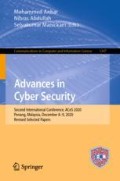Abstract
Web services are now a critical element of many of our day-to-day activities. Their applications are one of the fastest-growing industries around. The security issues related to these services are a major concern to their providers and are directly relevant to the everyday lives of system users. Cross-Site Scripting (XSS) is a standout amongst common web application security attacks. Protection against XSS injection attacks needs more work. Machine learning has considerable potential to provide protection in this critical domain. In this article, we show how genetic programming can be used to evolve detection rules for XSS attacks. We conducted our experiments on a publicly available and up-to-date dataset. The experimental results showed that the proposed method is an effective countermeasure against XSS attacks. We then investigated the computational cost of the detection rules. The best-evolved rule has a processing time of 177.87 ms and consumes memory of 8,600 bytes.
Access this chapter
Tax calculation will be finalised at checkout
Purchases are for personal use only
References
Ahmed, M.A., Ali, F.: Multiple-path testing for cross site scripting using genetic algorithms. J. Syst. Arch. 64, 50–62 (2016)
Alyasiri, H., Clark, J.A., Kudenko, D.: Evolutionary computation algorithms for detecting known and unknown attacks. In: Lanet, J.-L., Toma, C. (eds.) SECITC 2018. LNCS, vol. 11359, pp. 170–184. Springer, Cham (2019). https://doi.org/10.1007/978-3-030-12942-2_14
Aydogan, E., Yilmaz, S., Sen, S., Butun, I., Forsström, S., Gidlund, M.: A central intrusion detection system for RPL-based industrial Internet of Things. In: 2019 15th IEEE International Workshop on Factory Communication Systems (WFCS), pp. 1–5. IEEE (2019)
Chen, X.L., Li, M., Jiang, Yu., Sun, Y.: A comparison of machine learning algorithms for detecting XSS attacks. In: Sun, X., Pan, Z., Bertino, E. (eds.) ICAIS 2019. LNCS, vol. 11635, pp. 214–224. Springer, Cham (2019). https://doi.org/10.1007/978-3-030-24268-8_20
Chicco, D., Jurman, G.: The advantages of the Matthews correlation coefficient (MCC) over F1 score and accuracy in binary classification evaluation. BMC Genomics 21(1), 6 (2020)
Ellis, J.: Java agent for memory measurements. https://github.com/jbellis/jamm. Accessed 02 Oct 2018
Fang, Y., Li, Y., Liu, L., Huang, C.: DeepXSS: cross site scripting detection based on deep learning. In: Proceedings of the 2018 International Conference on Computing and Artificial Intelligence, pp. 47–51 (2018)
Hydara, I., Sultan, A.B.M., Zulzalil, H., Admodisastro, N.: Current state of research on cross-site scripting (XSS)-a systematic literature review. Inf. Softw. Technol. 58, 170–186 (2015)
Internetworldstats.Com: Internet growth statistics 1995 to 2019. https://www.internetworldstats.com/emarketing.htm. Accessed 19 Aug 2020
Kearney, M.W., Hvitfeldt, E.: textfeatures: Extracts Features from Text (2019). https://CRAN.R-project.org/package=textfeatures, r package version 0.3.3
Koza, J.R., Koza, J.R.: Genetic Programming: On the Programming of Computers by Means of Natural Selection, vol. 1. MIT press (1992)
Likarish, P., Jung, E., Jo, I.: Obfuscated malicious javascript detection using classification techniques. In: 2009 4th International Conference on Malicious and Unwanted Software (MALWARE), pp. 47–54. IEEE (2009)
Liu, M., Zhang, B., Chen, W., Zhang, X.: A survey of exploitation and detection methods of XSS vulnerabilities. IEEE Access 7, 182004–182016 (2019)
Luke, S.: ECJ evolutionary computation library (1998). https://cs.gmu.edu/~eclab/projects/ecj/
Marashdih, A.W., Zaaba, Z.F., Omer, H.K.: Web security: detection of cross site scripting in PHP web application using genetic algorithm. Int. J. Adv. Comput. Sci. Appl. (IJACSA) 8(5) (2017)
Montana, D.J.: Strongly typed genetic programming. Evol. Comput. 3(2), 199–230 (1995)
NTT: 2020 global threat intelligence report. https://hello.global.ntt/en-us/insights/2020-global-threat-intelligence-report. Accessed 19 Aug 2020
Nunan, A.E., Souto, E., Dos Santos, E.M., Feitosa, E.: Automatic classification of cross-site scripting in web pages using document-based and url-based features. In: 2012 IEEE Symposium on Computers and Communications (ISCC), pp. 000702–000707. IEEE (2012)
OWASP: Owasp top ten. https://owasp.org/www-project-top-ten/. Accessed 19 Aug 2020
Pham, T.A., Nguyen, Q.U., Nguyen, X.H.: Phishing attacks detection using genetic programming. In: Huynh, V.N., Denoeux, T., Tran, D.H., Le, A.C., Pham, S.B. (eds.) Knowledge and Systems Engineering. AISC, vol. 245, pp. 185–195. Springer, Cham (2014). https://doi.org/10.1007/978-3-319-02821-7_18
Poli, R., Langdon, W.B., McPhee, N.F., Koza, J.R.: A field guide to genetic programming. Lulu.com (2008)
Rathore, S., Sharma, P.K., Park, J.H.: XSSClassifier: an efficient XSS attack detection approach based on machine learning classifier on SNSS. J. Inf. Process. Syst. 13(4) (2017)
Sen, S.: A survey of intrusion detection systems using evolutionary computation. In: Bio-Inspired Computation in Telecommunications, pp. 73–94. Elsevier (2015)
Sen, S., Clark, J.A.: Evolutionary computation techniques for intrusion detection in mobile ad hoc networks. Comput. Netw. 55(15), 3441–3457 (2011)
Sommer, R., Paxson, V.: Outside the closed world: on using machine learning for network intrusion detection. In: 2010 IEEE Symposium on Security and Privacy, pp. 305–316. IEEE (2010)
Wang, R., Jia, X., Li, Q., Zhang, S.: Machine learning based cross-site scripting detection in online social network. In: 2014 IEEE International Conference on High Performance Computing and Communications, 2014 IEEE 6th International Symposium on Cyberspace Safety and Security, 2014 IEEE 11th International Conference on Embedded Software and System (HPCC, CSS, ICESS), pp. 823–826. IEEE (2014)
Wang, Y., Cai, W.D., Wei, P.C.: A deep learning approach for detecting malicious javascript code. Secur. Commun. Netw. 9(11), 1520–1534 (2016)
Wu, S.X., Banzhaf, W.: The use of computational intelligence in intrusion detection systems: a review. Appl. Soft Comput. 10(1), 1–35 (2010)
Zhang, B.: Detecting XSS attacks by combining CNN with LSTM (2019). http://dx.doi.org/10.21227/css6-ds36
Author information
Authors and Affiliations
Corresponding author
Editor information
Editors and Affiliations
Rights and permissions
Copyright information
© 2021 Springer Nature Singapore Pte Ltd.
About this paper
Cite this paper
Alyasiri, H. (2021). Evolving Rules for Detecting Cross-Site Scripting Attacks Using Genetic Programming. In: Anbar, M., Abdullah, N., Manickam, S. (eds) Advances in Cyber Security. ACeS 2020. Communications in Computer and Information Science, vol 1347. Springer, Singapore. https://doi.org/10.1007/978-981-33-6835-4_42
Download citation
DOI: https://doi.org/10.1007/978-981-33-6835-4_42
Published:
Publisher Name: Springer, Singapore
Print ISBN: 978-981-33-6834-7
Online ISBN: 978-981-33-6835-4
eBook Packages: Computer ScienceComputer Science (R0)

